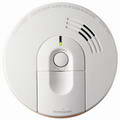| « Wiring Smoke Detectors | Adding Smoke Detectors » |
How to Wire Smoke Detectors

|
By Dave Rongey
Summary: How to Install and Wire Smoke Detectors - Installation Guide with Photos that clearly explain how Interconnected Smoke Detectors are wired so they function properly. © By: Dave Rongey |
Home Smoke Detector and Heat Alarms Overview and Information
Carbon Monoxide (CO) Alarms
CO Alarms are recommended near bedrooms and sleeping areas where they can wake sleeping residents.
Additional CO alarms are recommended 5-20 feet from sources of CO such as a furnace, water heater or fireplace.
Alarms can alert you to a problem only after smoke or CO reach their sensors.
Choose locations free of obstructions, where the alarm will stay clean and protected from adverse environmental conditions.
Smoke Alarms Resources:
Smoke Detectors and Alarms
Help Save Lives and Reduce Structural Destruction!
Studies show that smoke alarms save more lives than any other fire prevention measure. Smoke alarms provide the earliest warning of both fire and smoke.
Smoke Alarms
In a typical home fire, occupants have just minutes to escape. And because smoke in one area may not reach a smoke alarm in another, the National Fire Protection Association (NFPA) recommends placement of at least one smoke alarm on every level of the home (including basements) and/or in every bedroom or sleeping area. The NFPA also recommends interconnection of alarms to provide better whole-home protection than stand-alone alarms. Photoelectric smoke alarms respond to slow burning, visible smoke caused by smoldering fires. Well suited for use in kitchens and near baths, they are less susceptible to nuisance alarms caused by cooking or high humidity.
Combination Smoke/CO Alarms
A combination Smoke/CO Alarm makes it easy to provide both types of protection throughout the home. A combination alarm installed on every level of the home is an excellent way to ensure maximum protection for occupants, with a minimum of installation effort.Heat Alarms
In some areas of the house, it is important to use a heat alarm that senses fire by air temperature, rather than a smoke alarm that senses particles in the air. The installation of heat alarms in attics (finished or unfinished), furnace rooms or garages is recommended, since these locations occasionally experience conditions that can result in improper operation of smoke alarms. Most UL approved heat alarms are designed to alarm when presented with a certain temperature at the alarm. They will not react to smoke and should not be used to replace smoke alarms, but as a supplement to a complete smoke alarm system.[Click image to enlarge]
Lets take a look at some photos of recent projects that I have selected
A typical construction project will require a smoke detector in each bedroom and on the ceiling or wall at a point centrally located in the area giving access to bedrooms such as hallways. Mount smoke detectors at least 4 inches from wall or on the wall with the top of the detector within 4 inches and 12 inches of the highest point of the ceiling. In multi-story units there shall be a detector at each level and shall be placed at the center of the ceiling 24 inches or more higher than the hall are required to have a smoke detector on the hall ceiling and in the bedroom. In new construction when more than one smoke detector is required to be installed within an individual dwelling, the detectors shall be interconnected by installing the electrical wiring in such a manner that the actuation of one alarm will activate all of the alarms in the dwelling.
to help you see how its done.
|
||||||||||
|
The Safest Way to Test Electrical Devices and Identify Electric Wires!The Non-Contact Electrical TesterThis is a testing tool that I have had in my personal electrical tool pouch for years, and is the first test tool I grab to help identify electrical wiring. It is a Non-contact tester that I use to easily Detect Voltage in Cables, Cords, Circuit Breakers, Lighting Fixtures, Switches, Outlets and Wires. Simply insert the end of the tester into an outlet, lamp socket, or hold the end of the tester against the wire you wish to test. Very handy and easy to use.
The Quickest Way to Check for Faulty Electrical Wiring!The Plug-In Outlet TesterThis is the first tool I grab to troubleshoot a problem with outlet circuit wiring. This popular tester is also used by most inspectors to test for power and check the polarity of circuit wiring. It detects probable improper wiring conditions in standard 110-125 VAC outlets Provides 6 probable wiring conditions that are quick and easy to read for ultimate efficiency Lights indicate if wiring is correct and indicator light chart is included Tests standard 3-wire outlets UL Listed Light indicates if wiring is incorrect Very handy and easy to use.
Strip Off Wire Insulation without Nicking and Damaging the Electric Wire!The Wire Stripper and Wire CutterMy absolute favorite wire stripping tool that I have had in my personal electrical tool pouch for years, and this is the tool I use to safely strip electrical wires. This handy tool has multiple uses: The wire gauges are shown on the side of the tool so you know which slot to use for stripping insulation. The end of the tool can be used to grip and bend wire which is handy for attaching wire onto the screw terminals of switches and outlets.. The wire stripper will work on both solid and stranded wire. This tool is Very Handy and Easy to Use. |
||
Residential Electrical Parts and AccessoriesLight Switches 120volt Outlets Circuit Breakers Electrician Tools Voltage Testers |































